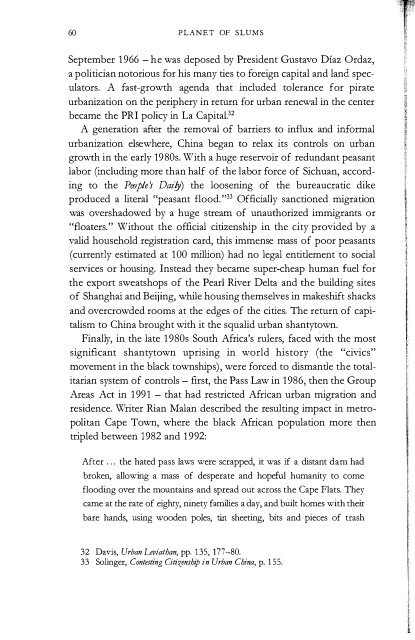Untitled - Rebel Studies Library
Untitled - Rebel Studies Library
Untitled - Rebel Studies Library
Create successful ePaper yourself
Turn your PDF publications into a flip-book with our unique Google optimized e-Paper software.
60 PLANET OF SLUMS<br />
September 1966 - he was deposed by President Gustavo Diaz Ordaz,<br />
a politician notorious for his many ties to foreign capital and land spec<br />
ulators. A fast-growth agenda that included tolerance for pirate<br />
urbanization on the periphery in return for urban renewal in the center<br />
became the PRI policy in La Capita1.32<br />
A generation after the removal of barriers to influx and informal<br />
urbanization elsewhere, China began to relax its controls on urban<br />
growth in the early 1980s. With a huge reservoir of redundant peasant<br />
labor (including more than half of the labor force of Sichuan, accord<br />
ing to the Peop!e DazIY) the loosening of the bureaucratic dike<br />
produced a literal "peasant flood."33 Of ficially sanctioned migration<br />
was overshadowed by a huge stream of unauthorized immigrants or<br />
"floaters." Without the official citizenship in the city provided by a<br />
valid household registration card, this immense mass of poor peasants<br />
(currently estimated at 100 million) had no legal entitlement to social<br />
services or housing. Instead they became super-cheap human fuel for<br />
the export sweatshops of the Pearl River Delta and the building sites<br />
of Shanghai and Beijing, while housing themselves in makeshift shacks<br />
and overcrowded rooms at the edges of the cities. The return of capi<br />
talism to China brought with it the squalid urban shantytown.<br />
Finally, in the late 1980s South Africa's rulers, faced with the most<br />
significant shantytown uprising in world history (the "civics"<br />
movement in the black townships), were forced to dismantle the total<br />
itarian system of controls - first, the Pass Law in 1986, then the Group<br />
Areas Act in 1991 - that had restricted African urban migration and<br />
residence. Writer Rian Malan described the resulting impact in metro<br />
politan Cape Town, where the black African population more then<br />
tripled between 1982 and 1992:<br />
After . .. the hated pass laws were scrapped, it was if a distant dam had<br />
broken, allowing a mass of desperate and hopeful humanity to come<br />
flooding over the mountains and spread out across the Cape Flats. They<br />
came at the rate of eighty, ninety families a day, and built homes with their<br />
bare hands, using wooden poles, tin sheeting, bits and pieces of trash<br />
32 Davis, Urban Leviathan, pp. 135, 177-80.<br />
33 Solinger, Contesting Citizenship in Urban China, p. 155.<br />
I<br />
THE TREASON OF THE STATE<br />
rescued from landfills and plastic garbage bags to keep out the rain. Within<br />
two years, the sand dunes had vanished under an enormous sea of shacks<br />
and shanties, as densely packed as a mediaeval city, and populated by fan<br />
tastic characters - bootleggers, gangsters, prophets, Rastafarians, gun<br />
dealers and marijuana czars, plus almost a million ordinary working<br />
people.34<br />
Broken Promises and Stolen Dreams<br />
The slum was not the inevitable urban future. In early 1960, for<br />
example, Cuba's new National Institute of Savings and Housing, led by<br />
the legendary Pastorita Nunez, began to replace Havana's notorious<br />
shantytowns (Las Yaguas, Llega y Pon, La Cueva del Humo, and so on)<br />
with prefabricated homes erected by the residents themselves. Seven<br />
years earlier, during his trial for the Moncada barracks attack, Fidel<br />
Castro had promised Cubans a revolution that would enforce the pro<br />
gressive 1940 Constitution's guarantee of decent housing. In 1958<br />
almost a third of Cubans lived in slums or squatter settlements.<br />
Accordingly, in the first golden years of the revolution, there was a<br />
huge national effort to rehouse the poor, even if many of the projects,<br />
in retrospect, were drab adaptations of modernism.35<br />
Although revolutionary Cuba's commitment to a "new urbanism"<br />
was avant-garde, the ideal of a poe1!lar_.e!i!lntJQ..Ql:s no!<br />
i unique in the contemporary-Third World in the late 1950s and early<br />
1960s: Nasser, Nehru, and Sukarno also promised to rebuild slums and<br />
create immense quanitities of new housing. In addition to subsidized<br />
housing and rent control, Nasser's "contract with Egypt" guaranteed<br />
public-sector jobs to every secondary-school graduate. Revolutionary<br />
Algeria legislated free universal healthcare and education, together with<br />
( rent subsidies for poor city-dwellers. "Socialist " African states, begin-<br />
1 ning with Tanzania in the early 1960s, all started off with ambitious<br />
programs to relocate urban slum-dwellers into new low-cost housing.<br />
Mexico City in the Uruchurtu years enlisted the services of stellar emigre<br />
architects, such as the Bauhaus's Hannes Meyer, to design highrise<br />
34 Rian Malan quoted in Westen, p. xxii<br />
35 Joseph Scarpaci, Roberto Segre, and Mario Coyula, Havana: Two Faces 0/ the<br />
Antillean Metropolis, Chapel Hill 2002, pp. 199-203.<br />
61


